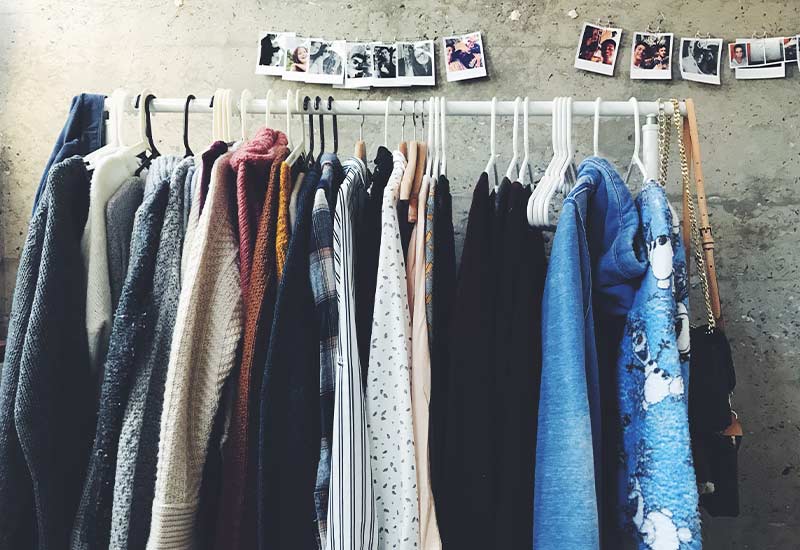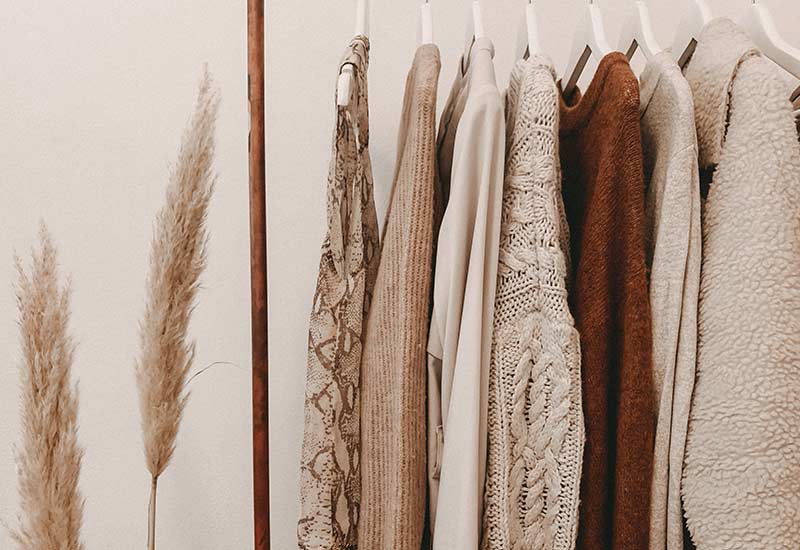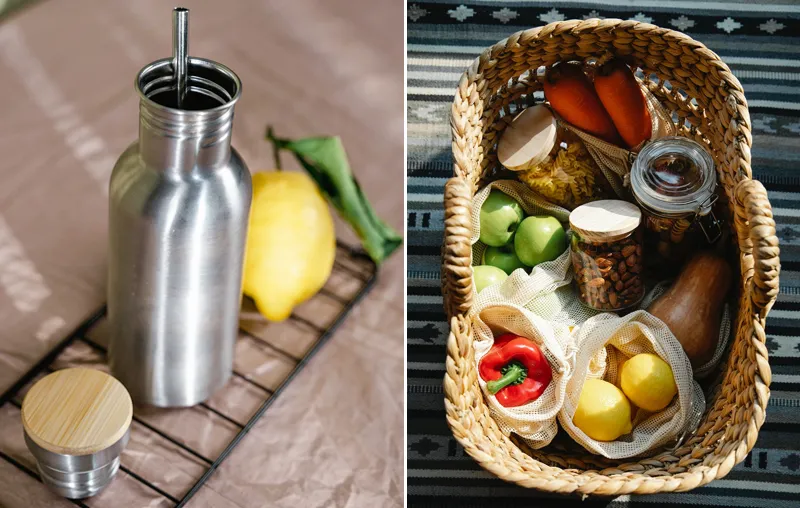Looking to create a sustainable closet? Then you've come to the right place! If you want to get your Making life more sustainable there is no way around dealing with the contents of your wardrobe. After all, the Fast Fashion Industry with low-quality but resource-intensive mass-produced goods from low-wage countries - and the new trends and designs that appear almost every week - contribute significantly to the social and economic development of the country. ecological challenges of our time at.
Fortunately, you can organize your closet with simple tools so that you no longer contribute to these problems, leaving only the things you really like and need.
In this article, I would like to introduce you to valuable tips that you can use to breathe more sustainability into your closet. Let's go!
In advance you can find a short overview of the article here:
- Making fashion problems aware
- Organize and clean out closet
- Care for what is already there
- Buy and sell second hand
- Join the 30 Wears Challenge
- Prefer quality over quantity
- Commit to minimalism
- Repair and remodel clothes
- Adapt Capsule Wardrobe
- Consume fair fashion
1. make fashion problems aware

Whether it's a coat, a sweater or a T-shirt - every cheap product in the fashion store has its own story, which usually can't be told without industrial waste water, Animal suffering, waste of resources or the Contempt for human rights can be told. Rivers and landscapes are poisoned, workers are exploited and their health endangered, animals are tortured and killed for their fur, and vast amounts of water and energy are consumed.
These consequences of the production of cheap clothing are all the more alarming when one knows that we Germans, on average, make about 40 percent of the things in our closet not wear them at all or only extremely rarely.₁
Movie Tip: "The True Cost" impressively presents the backgrounds and stories of seemingly cheap fast fashion products. Seemingly cheap, because the real costs are not borne by the buyer, but by the environment, as well as other people and animals.
2. organize and clean out closet
Motivation enough? Good! So what can you do to make your own closet more sustainable? First of all, it is necessary to check what is there, what you like and what you do not wear at all.
Maybe you know that moment when you're standing in front of your overstuffed closet and you're still looking at the feel like you have nothing to wear? Then you'll definitely have an easy time cleaning out and creating a pleasant overview of your wardrobe.
Good to know: By the way, this is the case for most people. On average according to Greenpeace every German has about 95 items of clothing in his or her closet - not even counting underwear and socks. Quite a lot, don't you think?
3. cherish and care for what is already there
After mucking out what remains is what you like and really need. The rest is sold or given away, pleases your wallet and someone else.
The clothes that now adorn your more sustainable wardrobe should be cherished and treated well. Observe all care symbols, keep moths away with lavender or cedar wood, untie knots from wool sweaters, wash as rarely as possible and air dry. Or in short: Treat your clothes as if you can't buy a new piece anytime you want.
4. buy and sell second hand

Your commitment to a sustainable closet pays off not only for the environment, but also for your wallet. For example, by choosing second-hand fashion, you're giving back to the Existing clothing a second chance and Save money sustainably. At the same time you get unique pieces in vintage look, instead of lame mass-produced.
You can of course just as well Conversely, give your discarded but still wearable parts to a thrift storeso that someone else can be happy about it. Either way, second-hand fashion really belongs in every sustainable wardrobe.
5. Join the 30 Wears Challenge
The producer of the documentary "The True Cost - Der Preis der Mode" (The True Cost - The Price of Fashion) has started a challenge that leads us consumers to a more conscious approach to fashion. The task is to ask yourself the following question before every possible new purchase of a piece of clothing: Will I wear it at least 30 times?
If the answer is NO, you avoid a possible impulse purchase of things that you like in the short moment, but which you actually do not need. If the answer is YES, the object of desire may really fit into your sustainable closet - but of course that's not a guarantee.
6. give preference to quality over quantity
In a sustainable closet definitely belong things that are made of high quality, well-made material. Because durable garments do not need to be constantly replaced and exchanged - and thus protect the environment and your wallet. In the short term, you might spend a euro or two more - but in the long term, it's worth it for all sides, except the profit-oriented fast fashion industry itself.
7. commit to minimalism
A valuable part of the sustainable way of life, is the minimalist thinking and acting. Better a few things that you like but very well and that you really need, than many things that you never wear because you do not like them (more).
"Buy less, choose well, make it last."
Vivienne Westwood
This attitude will also help you to make your closet more environmentally friendly and sensible, and to avoid the provocations of advertising posters or celebrities on social media. Avoid impulse buying. The above quote from fashion designer Vivienne Westwood should certainly inspire you and means loosely translated as: buy fewer pieces that are carefully selected to be happy in the long run.
Tip: Does consumption make you unhappy? You can get the detailed answer to this question in the linked post.
8. repair and remodel clothes
One of your beloved sweaters has a hole? Then this is by no means a reason for the garbage can. How about if you replace it with patch yourself or have it patched? In this way you create an absolutely unique.
A sustainable wardrobe also includes garments that have merely been slightly altered and are subsequently completely newly interpreted can be. Not everyone can sew, that's for sure. But anyone can learn and then experience how much fun it is.
9. adapt Capsule Wardrobe

A nice addition to the minimalism tip mentioned above is the concept of the Capsule Wardrobe. It describes a perfect basic set of as few clothes as possible, which are very versatile and can be easily combined with each other.
The most timeless garments possible ultimately save you further, expensive purchases and protect natural resources. To do this, it is important that you analyze your closet, check different combinations and not taking yourself too seriously. So you will definitely get many, beautiful outfits together from as few pieces as possible.
10. consume fair fashion
It is not always possible to avoid a new purchase. Durability, high-quality workmanship, environmentally and resource-friendly production, fair payment and treatment of all parties involved in a supply chain - that sounds great, doesn't it?
By preferring clothes with sustainable seals and labels and fashion from companies with a green philosophy, you support the production of such future-oriented, fair fashion goods. More and more suppliers are thinking sustainably.
So when you buy new clothes, buy them where you can be sure they will fit into your sustainable closet.
Sustainable closet? No problem!
There is one advantage to buying clothes in abundance: the potential to make your wardrobe more environmentally friendly, minimalist and fair is huge! Accordingly, the implementation is usually also simple. As you've learned today, the most important thing is to know why it's worth taking this step - and then how to take it.
Go for quality and durability, think minimalist, buy second-hand and prefer clothes from brands that follow a sustainable philosophy.
Do you have any questions, tips or suggestions about "sustainable closet"? Then I look forward to your comment!
Stay sustainable,

PS.: Under sustainable shopping on the internet you get additional tips that should help you!
References:
₁ https://www.greenpeace.de/sites/default/files/publications/20151123_greenpeace_modekonsum_flyer.pdf





